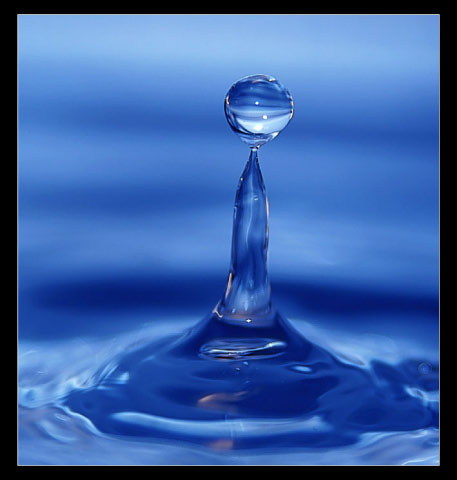Eau de source à
PARIS.
Spring
water in PARIS.


Pour obtenir de l'eau de la nappe phréatique deux méthodes
principales sont utilisées :
1° Le puits de surface:
On appelle puits de surface un puits qui s'approvisionne
directement dans la nappe phréatique.
To obtain from some water of the groundwater
two main methods are used:
1 ° The well of surface:
We call well of surface a well which stocks up directly in the
groundwater.

2° Le puits artésien :
Un puits artésien est un puits où l'eau jaillit spontanément. Ce
phénomène a été mis en évidence pour la première fois par les
moines de l'abbaye de Lillers, en Artois en 1126, d'où son
nom.
L'artésianisme se produit lorsque la configuration particulière de
la géologie d'un lieu et sa topographie provoquent une telle mise
en pression de l'aquifère que la ligne piézométrique
« sort » du sol.
2 ° The artesian well:
An artesian well is a well where the water springs spontaneously.
This phenomenon was put in evidence for the first time by the monks
of the abbey of Lillers, in Artois in 1126, where from his(her,its)
name.
The artésianisme occurs when the particular configuration of the
geology of a place and its topography provoke such a stake in
pressure of the aquifer as piézométrique line her(it) "Leave" the
ground.

Un aquifère est une couche de terrain
ou une roche, suffisamment poreuse (qui peut stocker de l'eau) et
perméable (où l'eau circule librement), pour contenir une nappe
d'eau souterraine. Une nappe d'eau souterraine est un réservoir
naturel d'eau douce susceptible d'être exploitée.
An aquifer is a coat(layer) of ground or a rock, porous enough (who
can store some water) and permeable (where the water circulates
freely), to contain a ground-water. A ground-water is a natural
reservoir of fresh water susceptible to be
exploited(run).
La nappe phréatique est la nappe contenue dans l'aquifère de
surface, et qui est assez peu profonde pour alimenter les
puits.
La nappe phréatique : is the
tablecloth contained in the aquifer of surface, and which is rather
little deep to feed wells.
Aquiclude : matériau comme les argiles, les granites ou les
calcaires compacts où l'eau s'écoule très lentement (quelques
millimètres par an)
Aquiclude : material as clays,
granites or compact limestones Aquiclude where the water passes by
very slowly (some millimeters a year)
Géologie et qualité des eaux à PARIS.
La réalisation de puits artésiens à Paris a
été rendue possible par la présence de la nappe aquifère de
l'Albien et les progrès de la technologie du forage à partir des
années 1830. La volonté de produire une eau saine à bon marché fit
apparaître des puits artésiens tout au long du XIXe siècle et au
début du XXe.
Pour atteindre la nappe aquifère, à environ 600 m de profondeur, il
faut traverser toutes les couches de l'éocène et du crétacé
supérieur, jusqu'aux argiles imperméables du Gault qui retiennent
l'eau renfermée dans la couche sableuse de l'Albien.
Les eaux des différents puits artésiens de Paris sont très
similaires entre elles dans leur composition : moins calcaires et
moins magnésiennes que les eaux de distribution habituelles, elles
sont en revanche un peu plus ferrugineuses.
L'eau des puits artésiens de Passy et de la Butte-aux-Cailles est
mise à la disposition du public : chacun peut venir y remplir
librement ses récipients. Ses qualités gustatives et chimiques sont
conformes à ce que l'on attend d'une eau de source ; jaillissant à
28°C, elle doit cependant être réfrigérée avant consommation.
Geology and quality of waters
in PARIS.
The achievement of
artesian wells in Paris was made possible by the presence of the
aquifer Albian and advances in drilling technology from the 1830s.
The desire to produce clean water cheaply made shows artesian wells
throughout the nineteenth and early twentieth.
To reach the aquifer, about 600 m deep, it must pass through all
layers of the Cretaceous and Eocene higher impervious to the Gault
clay that hold water enclosed in the layer of the Albian
sandy.
The waters of the artesian wells of Paris are very similar between
them in their composition: less and less magnesium limestone that
water distribution usual, they are nevertheless a little more
iron.
Water from artesian wells Passy and "the Butte-aux-cailles" is
available to the public: anyone can freely come and fulfill its
containers. Its taste and chemical conform to what is expected of a
spring water, gushing at 28 ° C, it must be refrigerated prior to
consumption.

Puits artésien de la
Butte-aux-Cailles
C'est dans le courant de l'année 1863 que le préfet Haussmann
décida de lancer les travaux de forage du puits artésien de ce
quartier du XIIIème arrondissement. C'était une nécessité
pour alimenter l'arrondissement et augmenter ainsi le débit de la
Bièvre.
Ce n'est qu'au début du XXème siècle et sous la direction d'Arago,
que le projet fut mené à son terme, partiellement car la Bièvre
était partiellement recouverte et car des habitations de la Butte
avaient déjà l'eau courante. L'eau puisée était tiède, abondante et
d'excellente qualité étant donnée la profondeur du forage.
En 1924, on trouva une autre utilité à cette fontaine : alimenter
la piscine de la Butte, cette piscine de l'architecte Louis Bonnier
qui est l'une des plus anciennes de France.
Le puits se trouve sur la Place Verlaine.
La fontaine récemment construite sur la place met l'eau à la
disposition du public. Il s'agirait d'une des meilleures eaux de
PARIS (voir ce lien :
 ) et celui ci :
) et celui ci :

Pour valider votre
visite:
Joindre une photographie de vous ou de votre gps devant la
fontaine.
M'indiquer par mail (voir mon profil) le nombre de marches de
l'escalier de pierre tout proche menant à la rue du Moulin des près
et la profondeur du puits en mètres.
Apporter vos impressions sur la qualité de l'eau.
Artesian wells in the Butte-aux-Cailles.
In the year 1863 as the prefect Haussmann decided to launch the
work of drilling artesian wells in the area of the XIII
arrondissement. It was a necessity to feed the borough and
increase the flow of the Bièvre.
It was only the beginning of the twentieth century and under the
direction of Arago, that the project was completed, partly because
Bièvre was partially covered and because housing Butte had running
water. Water was drawn warm, abundant and excellent given the depth
of drilling.
In 1924, it found another use for that fountain: power pool of
Butte, this pool of the architect Louis Bonnier, one of the oldest
in France.
The well is located on the Place Verlaine.
The fountain recently built on the site is water available to the
public. It would be one of the best water PARIS (see this
link:
 ) and this one:
) and this one:

To complete your visit:
Attach a photograph of yourself or your gps to the fountain.
Please Indicate me by e-mail (via the profile) the number of the staircase's marchs of
quite close stone leading to the "Moulin des près" 's street and
the depth of the well in metres.
Provide feedback on the water quality.
Rappel concernant les « Earthcaches »: Il n'y a pas de conteneur
à rechercher ni de logbook à renseigner. Il suffit de se rendre sur
les lieux et d'exécuter les requêtes du geocacheur (par exemple
l'envoi d'un mail pour validation)
Reminder(Abseiling) concerning "Earthcaches": there is no
container to be looked for nor of logbook to inform. It is enough
to go(surrender) on the scene and to execute the requests of the
geocacheur (for example the sending of an e-mail for
validation)

| I am a proud |
 |